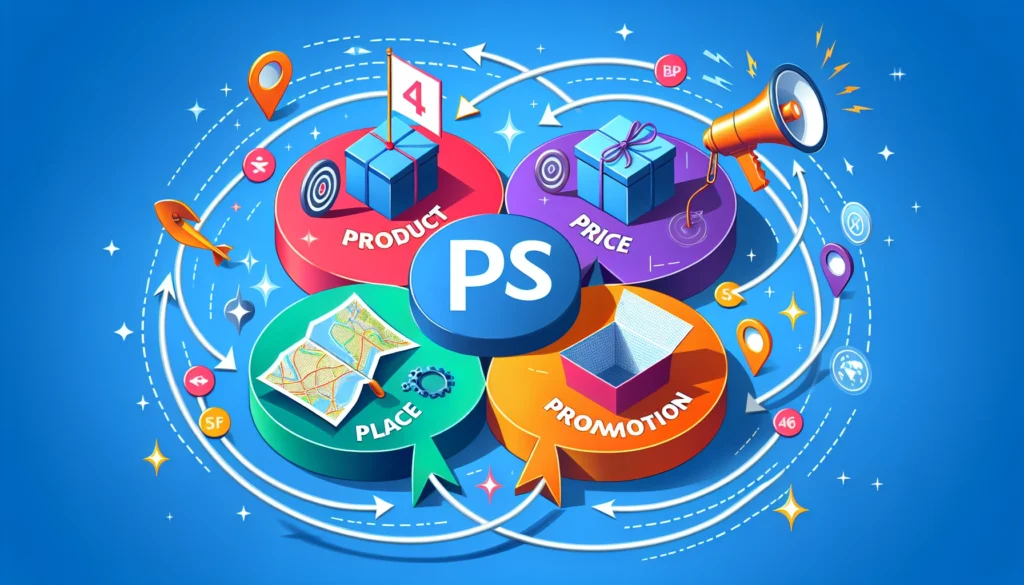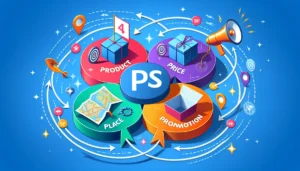Table of Contents[Hide][Show]
Achieving the right marketing mix is about balancing various marketing tactics to meet your business goals. Understanding your target market is crucial for creating an effective marketing mix, as it helps tailor your product, price, place, and promotion strategies to meet the needs and preferences of your audience. This article outlines how to create the right marketing mix, covering key elements like product, price, place, and promotion. Discover the steps to optimize your strategy for better customer engagement and higher sales.
Key Insights
The marketing mix, including the 4Ps (Product, Price, Place, Promotion), is the foundation of any marketing strategy and must be balanced to improve customer satisfaction, brand loyalty, and profitability.
The expanded 7Ps model (including People, Process, and Physical Evidence) provides a more comprehensive framework to enhance customer interactions and brand credibility, particularly for service and digital sectors.
Customizing the marketing mix for digital platforms, especially integrating personalized strategies and multi-channel approaches, is essential for effectively engaging modern consumers and aligning marketing efforts with business goals.
Understanding the target market is crucial for tailoring the marketing mix to meet customer needs and preferences and ensuring that the product is marketed and sold in a place that best suits the target market.
What is the Marketing Mix?

The marketing mix is a fundamental concept in business and advertising, serving as the foundation for all marketing efforts. At its core, it’s a strategic tool that helps companies make crucial decisions about presenting their products or services to their target market. Understanding the target market’s needs and preferences is essential for tailoring the marketing mix effectively. The concept was first formally introduced by Professor Jerome McCarthy in the 1960s, who proposed the now-famous “4Ps” framework:
Product
Price
Place
Promotion
This robust framework has stood the test of time, proving its worth in countless marketing campaigns across various industries. The beauty of the marketing mix lies in its versatility and adaptability. It allows companies to differentiate themselves from competitors by uniquely adjusting each variable, improving customer satisfaction and brand loyalty.
Moreover, a well-balanced marketing mix can significantly enhance profitability by optimizing pricing, distribution, and promotional strategies. In today’s rapidly changing market conditions, the marketing mix’s ability to adapt to consumer preferences and competitive landscape shifts is more valuable than ever.
The Core Elements of the Marketing Mix
At the heart of the marketing mix lie the four primary elements:
Product
Price
Place
Promotion
These four Ps form the cornerstone of any successful marketing strategy, working harmoniously to create a cohesive and practical approach to reaching and engaging customers. Each element plays a crucial role in shaping how consumers perceive, value, and purchase a product or service.
A balanced consideration of these four factors empowers businesses to craft a marketing strategy that resonates with their target audience while distinguishing themselves from competitors. Each element should be tailored to meet the target market’s needs to ensure maximum effectiveness. Let’s dive deeper into each of these core elements to understand their significance and how they contribute to the overall marketing mix.
Product

The ‘Product’ element is the foundation of any marketing mix, representing the item or service that a company offers to satisfy customer needs and wants. It’s not just about a product’s physical attributes; it encompasses everything from its features and benefits to its branding and packaging. A successful product fills a gap in the marketplace, addressing a need that isn’t currently being met or improving upon existing solutions. This is why understanding your target market is critical in product development and marketing.
As you define your product within the marketing mix, crucial considerations include its function, target audience, and unique selling points compared to competing products. This deep understanding of your product and its place in the market forms the basis for all other marketing decisions. Remember, a product that doesn’t resonate with your target audience or fulfill a genuine need will struggle to succeed, no matter how well you execute the other marketing mix elements.
Creating a product that genuinely enriches your customers’ lives paves the way for a winning marketing strategy.
Price

Price is a vital part of the traditional marketing mix. It represents the amount customers are willing to pay for a product or service. Pricing strategy is not just about covering costs and generating profit; it plays a crucial role in shaping customer perceptions of value and positioning your product in the market.
Setting the right price involves a delicate balance between:
Understanding your target market’s willingness to pay
Examining competitor prices
Considering costs related to research and development, manufacturing, marketing, and distribution.
Various pricing strategies should be considered, each with its own advantages and potential pitfalls. Value-based pricing focuses on the perceived value to the customer, while cost-plus pricing ensures a specific profit margin. Seasonal discounts can help boost sales during slower periods, and trade-in deals can encourage customer loyalty. Setting various price points for different demographics is crucial, considering that inappropriate pricing strategies can potentially alienate cost-sensitive customers or diminish your brand’s value.
Remember, pricing is not a one-time decision; it should be regularly reviewed and adjusted based on market conditions, competitor actions, and changes in your costs or product offerings.
Place

The “Place” component of the marketing mix refers to where and how your product or service is sold and distributed to your prospects. In today’s digital age, this concept has expanded beyond physical locations to include various online channels. Selecting the right place is crucial for connecting with your target audience and ensuring the success of your marketing strategy. It’s about making your product accessible to users at a convenient time and place, giving you a competitive advantage in the market.
In contemplating the ‘Place’ component, thorough research into physical locations and digital channels your target audience prefers is paramount. It is essential to select distribution channels based on the preferences of your target market to ensure that your product is available where they are most likely to shop. This could include:
Retail stores
Online marketplaces
Social media platforms
Your own e-commerce website
The type of product you’re selling should also influence your distribution decisions. For instance, luxury items might benefit from exclusive boutique settings, while everyday products might require widespread availability in supermarkets or convenience stores. Remember, choosing the wrong sales channels can make your entire retail strategy ineffective.
The goal is to select distribution channels that reach your target customer and align with your brand image and overall marketing objectives.
Promotion

Promotion is the fourth ‘P’ in the marketing mix, encompassing all the ways a company communicates with its target audience about its product or service. This element includes various activities such as advertising, sales promotion, personal selling, and public relations. The goal of promotion is not just to inform potential customers about your product, but to persuade them to make a purchase and build long-term relationships with your brand. Crafting promotional messages that resonate with the target market is crucial for effective communication. In the digital age, promotional channels have expanded to include social media marketing, content marketing, email campaigns, and search engine optimization. There are even effective off-line promotion strategies you can leverage such as freebie marketing.
Several key factors go into the creation of an effective promotional strategy. Here are some key considerations:
Your promotional messages should incorporate details from the other three Ps, ensuring a cohesive marketing mix.
Determine the best mediums to reach your target audience, whether through traditional channels like print and TV or digital platforms like social media and email.
Decide on the frequency of your communications to maintain engagement without overwhelming your audience.
Importantly, your brand voice should remain consistent across all marketing efforts, whether fun, clever, upscale, luxurious, or serious and intellectual.
Remember that the appropriate promotional strategy, combined with a well-crafted brand strategy, can significantly influence the conversion of leads into sales and foster customer loyalty.
Expanding Beyond the 4 Ps
While the 4Ps model has been a cornerstone of marketing strategy for decades, the increasing complexity of markets and the direct interaction between businesses and customers have necessitated an expansion of this framework. In 1981 as marketing evolved and customer service became more important Bernard H. Booms and Mary J. Bitner added three more Ps: people, physical evidence and processes. This gave us the 7 Ps of marketing. Enter the 7Ps model, which builds upon the original four elements (Product, Price, Place, and Promotion) by adding People, Process, and Physical Evidence.
Understanding the target market is essential when considering these additional elements, as it helps businesses tailor their strategies to meet their audience’s specific needs and preferences. This extended model provides a more comprehensive blueprint for companies to create successful marketing strategies, particularly in the service and digital sectors where customer experience is pivotal.
Including these additional elements enables companies to mold customer interactions more effectively, optimize operations, and provide concrete proof of their brand’s value. Let’s explore these new elements to understand how they contribute to a more robust and effective marketing mix.
People

The ‘People’ element in the expanded marketing mix recognizes the crucial role that human interactions play in shaping customer perceptions and experiences. This component encompasses not just employees who directly interact with customers, but anyone who represents the product or comes in contact with the consumer, including:
business partners
brand ambassadors
online community managers
These individuals engage with customers on behalf of the brand.
The importance of the ‘People’ element cannot be overstated, particularly in service-oriented businesses where customer interactions are frequent and impactful. Employees interacting with clients or customers are pivotal in representing the company and shaping brand perception. Therefore, these individuals must be well-trained and possess the appropriate skills to enhance the customer experience. Moreover, their behavior and attitudes must align with the company’s values to positively influence customer perceptions. Understanding the target market is crucial to ensure these interactions are positive and meet customer expectations. By investing in your people – through training, empowerment, and fostering a positive company culture – you can create a powerful differentiator that sets your brand apart from competitors and builds lasting customer relationships.
Process

The ‘Process’ element of the marketing mix refers to the methods and systems by which a product or service is delivered to the customer. This encompasses everything from the initial customer interaction to the final delivery and after-sales support. In essence, the marketing process is about how you do business and plays a crucial role in ensuring customer satisfaction and loyalty. Efficient processes contribute significantly to a seamless customer experience, which can be a key differentiator in today’s competitive marketplace.
When optimizing your processes, focusing on making them customer-friendly and efficient is essential. This could involve streamlining your sales funnel, simplifying the user journey from brand discovery to purchase, or improving your customer support systems. For instance, understanding the user journey in digital marketing is vital to simplifying the sales funnel and improving conversion rates. Additionally, understanding your target market is crucial to optimizing these processes effectively.
Regularly reviewing and refining your processes based on customer feedback is crucial to staying competitive and meeting evolving customer needs. A well-structured process not only augments customer satisfaction but also boosts operational efficiency, opening up possibilities for cost savings and enhanced profitability.
Physical Evidence

Physical Evidence in the marketing mix refers to the tangible elements that help consumers evaluate and experience a brand, product, or service. In the traditional sense, this might include the physical appearance of a store, the packaging of a product, or the uniforms worn by staff. However, in the digital age, the concept of Physical Evidence has evolved to encompass a brand’s entire digital footprint. This includes a well-designed website, an active and engaging social media presence, and customer testimonials or reviews.
Physical evidence has become even more crucial for businesses operating primarily or exclusively online. It serves as proof that the product or service exists and is credible, often representing the first point of contact between a customer and the brand. Some examples of Physical Evidence for online businesses include:
A professional, user-friendly website that instills confidence in potential customers
A strong social media presence that helps build brand personality and foster community engagement
Customer testimonials, case studies, and portfolio showcases provide social proof and demonstrate the value of your offerings.
Understanding the target market is essential to create compelling physical evidence that resonates with potential customers and meets their expectations.
By carefully curating these digital touchpoints, businesses can create a cohesive and compelling brand experience that resonates with their target audience and reinforces their market position.
Customizing Your Marketing Mix for Digital Marketing

In today’s digital-first world, customizing your marketing mix for online channels is not just an option – it’s a necessity. The digital landscape has transformed how businesses interact with customers, opening new opportunities for targeted, personalized marketing. Understanding your target market is crucial to tailor digital marketing efforts effectively. With 72% of marketing budgets now allocated to digital channels, it’s clear that the future of marketing is increasingly digital, and online marketing plays a crucial role. This shift is further underscored by the explosive growth of e-commerce, with global retail e-commerce sales exceeding $5 trillion in 2021 and projected to surpass $8 trillion by 2026.
Adapting your marketing mix for digital platforms involves rethinking each element through a digital lens. Here are some ways to do that:
Product: Offer digital versions or complementary online services.
Price: Utilize real-time data and algorithms for personalized pricing.
Place: Utilize e-commerce platforms and mobile apps.
Promotion: Leverage content marketing, email campaigns, display ads, and social media marketing.
Personalization: Tailor messages to specific users through channels like GA4 and consumer engagement reports.
The digital space allows for unprecedented levels of personalization, enabling marketers to reach their target audience more effectively.
Successful digital marketing strategies often involve a multi-channel approach, leveraging various marketing tools to reach and engage target audiences. For instance, businesses can communicate through:
Sponsored ads
Instagram posts
Email newsletters
Understanding your audience’s online behavior and preferences is crucial to choosing the most effective channels. For example, if targeting Gen Z, focusing on platforms like TikTok or Instagram might be more effective than Facebook or LinkedIn. Remember that the digital landscape is constantly in flux, necessitating agility and readiness to modify your strategy as new platforms and technologies surface.
Aligning the Marketing Mix with Business Goals
Aligning your marketing channels with your broader business goals is crucial for achieving efficient marketing results and driving sustainable growth. This alignment ensures that every aspect of your marketing strategy contributes directly to your company’s objectives, whether that’s increasing market share, boosting profitability, or expanding into new markets. Understanding the target market is essential to ensure your marketing efforts align with your business goals, as it helps define the customer experience and imagine how they will use your product. When your marketing efforts align with your business goals, you can more effectively translate increased engagement into tangible outcomes like higher profits and an expanded customer base.
Establish clear and realistic marketing goals to attain this alignment that bolsters your overarching business objectives. These goals should be specific, based on your unique selling proposition, and follow the SMART framework (Specific, Measurable, Achievable, Relevant, Time-bound). For instance, if your business aims to increase market share, your marketing objectives include increasing brand awareness among a specific demographic or boosting customer acquisition rates. Remember, effective goal-setting allows organizations to flesh out their action plans, align departments, and make faster, more informed decisions.
Having set your goals, concentrate on devising strategies that foster customer loyalty and accommodate customers’ changing needs. This might involve:
Conducting market research to understand customer demand and identify your competitive advantages
Regularly reassessing your customers’ needs and communicating frequently to ensure your marketing strategy remains relevant and effective
Continuously refining and improving your processes based on customer feedback to stay competitive
By creating a cohesive and consistent customer experience that aligns with your business goals, you can drive customer satisfaction, encourage repeat business, and generate valuable referrals.
Measuring the Success of Your Marketing Mix
Measuring the success of your marketing mix is crucial for understanding the effectiveness of your strategies and making data-driven decisions. Understanding your target market is essential to measure the effectiveness of your marketing efforts and ensure your strategy resonates with your audience. In today’s digital age, a wealth of metrics and data points are available to marketers, allowing for detailed analysis of marketing performance. Key metrics to track include:
Cost per lead (CPL)
Marketing qualified leads (MQLs)
Customer retention rates
Sales revenue
For digital advertising campaigns, impressions across search engines and social media platforms are important to monitor, making social media advertising a crucial aspect to consider.
Each of these metrics provides valuable insights into different aspects of your marketing mix:
Cost per lead (CPL) helps you understand the efficiency of your lead generation efforts by measuring the expense to acquire a lead.
Marketing ROI gives you a clear picture of the return on your marketing investments.
Customer lifetime value (CLV) is particularly important as it measures the total revenue expected from a customer over their entire relationship with your business. This helps you focus on long-term customer relationships rather than just short-term sales.
Ongoing analysis of these results and fine-tuning your strategies according to the data facilitates adaptation to shifting consumer preferences and requirements. This iterative process of measurement, analysis, and adjustment is critical to maintaining an effective marketing mix in a dynamic market environment. Remember, the goal isn’t just to collect data, but to derive actionable insights that can drive improvements across your marketing efforts. With regular tracking and optimization of your marketing mix guided by these metrics, you can maintain alignment of your marketing strategies with your business goals and ensure sustained value delivery to your customers and your organization.
Common Mistakes to Avoid
While crafting an effective marketing mix can significantly boost your business’s success, there are several common pitfalls that marketers should be aware of and actively avoid. One of the most frequent mistakes is poor customer segmentation, which can lead to ineffective marketing strategies. Without a clear understanding of your target audience, your marketing efforts may miss the mark, wasting resources and failing to resonate with potential customers. Understanding your target market is crucial to avoid these ineffective strategies and ensure your marketing efforts are well-directed.
Another common error is inconsistent monitoring of the marketing mix. The market is dynamic, and consumer preferences can change rapidly. Failing to regularly review and adjust your marketing mix can result in missed opportunities and a disconnect between your offerings and customer needs.
Developing a rigid marketing mix that doesn’t adapt to market changes is equally detrimental. Flexibility is vital in today’s fast-paced business environment. Additionally, inconsistent branding across different elements of the marketing mix can confuse customers and dilute your brand message.
Some common basic marketing mistakes to avoid include:
Failing to define clear goals and objectives
Neglecting to identify and target the right audience
Not conducting thorough market research
Overlooking the importance of branding and positioning
Relying solely on one marketing channel
Rushing marketing campaigns without proper planning
Ignoring customer feedback
You can create a more robust and effective marketing strategy by being aware of these common mistakes and actively working to avoid them.
Case Studies of Successful Marketing Mix Implementations
Examining real-world examples of successful marketing mix implementations can provide valuable insights and inspiration for businesses looking to enhance their marketing efforts. Understanding the target market is crucial in these case studies, as it helps companies tailor their strategies to meet their audience’s specific needs and preferences. Let’s look at a few standout cases demonstrating the power of a well-crafted marketing mix.
Converse, the iconic shoe brand, has leveraged Instagram as a key component of its marketing mix with remarkable success. Its strategy includes collaborations with influential creators like Tyler, the Creator, which has resulted in significantly higher engagement rates compared to its competitors. This approach showcases how effectively integrating social media into your promotional mix can boost brand visibility and customer engagement.
Similarly, Warby Parker, the eyewear company, launched their ‘Wearing Warby’ campaign, featuring influencers using their glasses daily. This strategy promoted their products and enhanced the brand’s approachability, demonstrating how the right promotional tactics can shape brand perception.
In the realm of content marketing, Fractl’s work with porch.com serves as an excellent example of how content can drive significant results. Through strategic content creation and distribution, they helped porch.com earn 931 unique domain links and 23,000 monthly organic visits. This case underscores the power of content marketing in improving SEO and driving organic traffic.
Zapier, on the other hand, took a different approach to SEO by creating over 25,000 unique landing pages targeting relevant long-tail keywords. This strategy significantly improved their search engine visibility and organic traffic.
Summary
As we’ve explored throughout this comprehensive guide, crafting an effective marketing mix is both an art and a science. From understanding the core elements of the 4Ps to expanding into the 7Ps for a more holistic approach, we’ve seen how each component plays a crucial role in shaping a successful marketing strategy. The digital revolution has transformed the marketing landscape, offering new opportunities for personalization and engagement, but also demanding adaptability and continuous learning. Remember, aligning your marketing mix with your business goals, measuring its success through key metrics, and avoiding common pitfalls are essential in optimizing your marketing efforts.
The case studies we’ve examined demonstrate that with creativity, data-driven decision-making, and a deep understanding of your target audience, you can create a marketing mix that resonates with customers and drives tangible business results. As you develop or refine your marketing mix, keep in mind that it’s an iterative process. Stay agile, be willing to experiment, and always keep your customer at the center of your strategy. Understanding your target market is crucial, as it helps tailor your marketing efforts to meet their needs and preferences. With these principles in mind, you’re well-equipped to navigate the dynamic world of marketing and propel your business to new heights of success.
Frequently Asked Questions
What is the marketing mix and why is it important?
The marketing mix is a strategic tool that includes key elements such as Product, Price, Place, and Promotion, which businesses use to effectively market their products or services. It is important because it provides a framework for making strategic decisions about presenting and selling offerings to target customers, allowing businesses to align with customer needs and market demands.
How has digital marketing changed the traditional marketing mix?
Digital marketing has transformed the traditional marketing mix by expanding the concept of ‘Place’ to include online platforms, transforming ‘Promotion’ to include digital advertising, allowing for more dynamic ‘Pricing’ strategies, and enabling the creation of digital ‘Products’. It has also emphasized the importance of ‘People’ in managing online interactions, ‘Process’ in creating seamless digital experiences, and ‘Physical Evidence’ in the form of websites and digital content.
What are some common mistakes to avoid when implementing a marketing mix?
When implementing a marketing mix, it’s important to avoid common mistakes like poor customer segmentation, inconsistent monitoring, rigid strategies, inconsistent branding, rushed campaigns, and ignoring customer feedback. These can significantly impact the effectiveness of your marketing efforts.
How can I measure the success of my marketing mix?
To measure the success of your marketing mix, track metrics like cost per lead, customer retention rates, marketing ROI, and sales revenue, along with digital campaign metrics like impressions and conversion rates. Regular analysis and comparison with your goals will help you assess effectiveness and identify areas for improvement.

 Key Blogging Statistics in 2024 – Trends, Facts and Insights
Key Blogging Statistics in 2024 – Trends, Facts and Insights